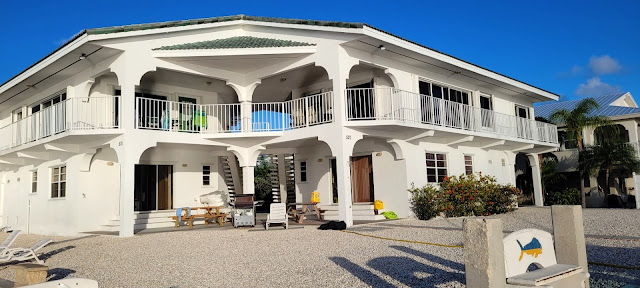Nope, the title isn’t talking about the
weather. It’s referring to the boat,
specifically the starboard engine. When is an engine overheat warning not an actual overheat condition? Read on.
Instrumentation Consternation
One slight anomaly we had noticed on the return leg from Marathon to Fort Myers back in late July was a suspiciously low water pressure indicator for the starboard engine. (Actually, it was Dan Eisenberg who noticed and pointed out the aberration when he was spelling Rick at the helm.) Under normal circumstances that gauge reading would essentially max out when moving along at planing speeds and just about any RPM above 3000. It’s mainly a health indicator for the raw water cooling passages in the big 425 HP four stroke outboard engine.
Theoretically, a low water pressure reading could indicate a restriction or blockage to the raw water pickup, or a failing impeller, perhaps even a faulting thermostat (there are at least two of those on the 425 XTO engine.) But any of those should also cause a corresponding temperature increase, and we were not seeing that (per the black arrow in the picture above.)
Once back at the dock, as a precaution we did verify that the water intake ports were clear, and then decided just to closely monitor the starboard engine.
On Friday 12-August we splashed the boat and started to motor towards Palm Harbor Marina about 30 miles to our north, with the intent of joining some boat of our club friends the next day for a lunch outing on Palm Island. The plan was to return home some time on Saturday. But we didn’t get far. Shortly after departure and getting Ghost Rider up on plane, we heard the piercing scream of the engine overheat warning and saw the attendant warning message on the instrument display.
 |
| Between the On-screen Warning and the Obnoxious Buzzer, the System Leaves No Doubt That You've Got Some Kind of Problem. |
It was pretty clear, however, the engine was not actually overheating (nor about to)….the engine temperature gauge was still dead center, and the tell-tale water exhaust port from the power head (“pee hole”) was still flowing strongly. But the Yamaha computer determined otherwise and put the engine into “Guardian mode” – severely limiting its range of RPM operation. So we reluctantly limped back to the dock.
Aftermath (Boat Business)
Rick had previously read about a Yamaha technical bulletin regarding faulting water pressure sensors, so he was 99% certain that was our issue. It took a few days to get the part ordered and delivered, but shortly after Rick had the cowling and required engine panels off the engine, the old sensor removed, and the new one installed. The engine panels took about 15 minutes to remove and replace; the sensor itself took all of 45 seconds.
 |
| Once the Cowling and Engine Panels are Removed the Water Pressure Sensor is Easily Accessible. |
Yamaha has also published a software update for the 425 XTO outboard in connection with this particular issue, modifying its code so that the Guardian mode isn’t invoked unless the temperature sensor (not just the water pressure sensor) also reports an actual overheat. That requires an authorized dealer or tech to apply, so for now it goes on the “to do” list. Rick also ordered another water pressure sensor for the spare parts inventory.
 |
| Pull Off the Wiring Harness, Unscrew the Bad Unit, Install the New One. Simple. |
Chelle was eager for some close quarters stick time, so for the ensuing sea trial she manned Ghost Rider’s helm, backed it off the lift and away from the dock, and then once in open waters put the boat through its paces while Rick monitored the engine’s gauges. It only took about 10 minutes to fully verify we were back to normal operation on the starboard engine throughout the operating RPM range.
One final note: provided one has the spare part onboard (and the seas aren’t too bouncy), this is a fix that can be done while enroute – all that is needed is the replacement sensor, the tool to remove the engine cover panels, and a crescent wrench. In retrospect, we should feel fortunate that sensor did not fail on the previous trip, halfway home from the Keys….that would have been a lengthy limp back home.
Still Looking at the Tropics
For this calendar year the prognosticators originally predicted 14 to 21 names storms and 6 to 10 hurricanes, of which 3 to 6 would be “major”. It wasn’t an unreasonable forecast given the La Nina in the Pacific, and the much warmer than normal air and sea temperatures throughout the Atlantic tropics….not to mention all the other extreme weather events clobbering the planet lately.
But it has now been over 50 days since the last named tropical system, and those three were mostly yawners. A combination of very dry and dusty air aloft (blowing off the Sahara desert) and unfavorable wind shear and pressure systems have kept things eerily calm apart our normal summer thunderstorm season. The folks at the Weather Channel seem both flummoxed and disappointed, while we down here in hurricane alley are quite content with the dullness.
That said, we are only halfway through the “season”, with the historical activity peak (mid-September) still several weeks away….so we know some nastiness will eventually develop. The experts seem undeterred, postulating the late start just means the season will extend longer this year. Eventually we’ll find out.



















